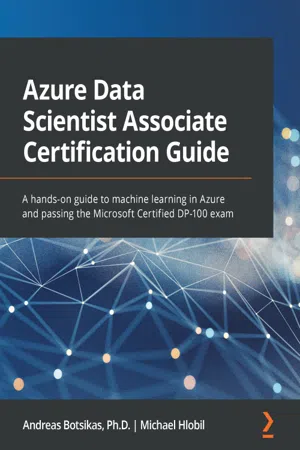
Azure Data Scientist Associate Certification Guide
Andreas Botsikas, Michael Hlobil
- 448 pagine
- English
- ePUB (disponibile sull'app)
- Disponibile su iOS e Android
Azure Data Scientist Associate Certification Guide
Andreas Botsikas, Michael Hlobil
Informazioni sul libro
Develop the skills you need to run machine learning workloads in Azure and pass the DP-100 exam with easeKey Features• Create end-to-end machine learning training pipelines, with or without code• Track experiment progress using the cloud-based MLflow-compatible process of Azure ML services• Operationalize your machine learning models by creating batch and real-time endpointsBook DescriptionThe Azure Data Scientist Associate Certification Guide helps you acquire practical knowledge for machine learning experimentation on Azure. It covers everything you need to pass the DP-100 exam and become a certified Azure Data Scientist Associate.Starting with an introduction to data science, you'll learn the terminology that will be used throughout the book and then move on to the Azure Machine Learning (Azure ML) workspace. You'll discover the studio interface and manage various components, such as data stores and compute clusters.Next, the book focuses on no-code and low-code experimentation, and shows you how to use the Automated ML wizard to locate and deploy optimal models for your dataset. You'll also learn how to run end-to-end data science experiments using the designer provided in Azure ML Studio.You'll then explore the Azure ML Software Development Kit (SDK) for Python and advance to creating experiments and publishing models using code. The book also guides you in optimizing your model's hyperparameters using Hyperdrive before demonstrating how to use responsible AI tools to interpret and debug your models. Once you have a trained model, you'll learn to operationalize it for batch or real-time inferences and monitor it in production.By the end of this Azure certification study guide, you'll have gained the knowledge and the practical skills required to pass the DP-100 exam.What you will learn• Create a working environment for data science workloads on Azure• Run data experiments using Azure Machine Learning services• Create training and inference pipelines using the designer or code• Discover the best model for your dataset using Automated ML• Use hyperparameter tuning to optimize trained models• Deploy, use, and monitor models in production• Interpret the predictions of a trained modelWho this book is forThis book is for developers who want to infuse their applications with AI capabilities and data scientists looking to scale their machine learning experiments in the Azure cloud. Basic knowledge of Python is needed to follow the code samples used in the book. Some experience in training machine learning models in Python using common frameworks like scikit-learn will help you understand the content more easily.
Domande frequenti
Informazioni
Section 1: Starting your cloud-based data science journey
- Chapter 1, An Overview of Modern Data Science
- Chapter 2, Deploying Azure Machine Learning Workspace Resources
- Chapter 3, Azure Machine Learning Studio Components
- Chapter 4, Configuring the Workspace
Chapter 1: An Overview of Modern Data Science
- The evolution of data science
- Working on a data science project
- Using Spark in data science
- Adopting the DevOps mindset
The evolution of data science
Working on a data science project

Understanding of the business problem

- Regression models allow you to predict a numeric value based on one or more features. For example, in Chapter 8, Experimenting with Python Code, you will be trying to predict a numeric value based on 10 measurements that were taken one year before the value you are trying to predict. Training a regression model is a supervised machine learning task, meaning that you need to provide enough sample data to train the model ...
Indice dei contenuti
- Azure Data Scientist Associate Certification Guide
- Contributors
- About the authors
- About the reviewers
- Preface
- Section 1: Starting your cloud-based data science journey
- Chapter 1: An Overview of Modern Data Science
- Chapter 2: Deploying Azure Machine Learning Workspace Resources
- Chapter 3: Azure Machine Learning Studio Components
- Chapter 4: Configuring the Workspace
- Section 2: No code data science experimentation
- Chapter 5: Letting the Machines Do the Model Training
- Chapter 6: Visual Model Training and Publishing
- Section 3: Advanced data science tooling and capabilities
- Chapter 7: The AzureML Python SDK
- Chapter 8: Experimenting with Python Code
- Chapter 9: Optimizing the ML Model
- Chapter 10: Understanding Model Results
- Chapter 11: Working with Pipelines
- Chapter 12: Operationalizing Models with Code
- Other Books You May Enjoy